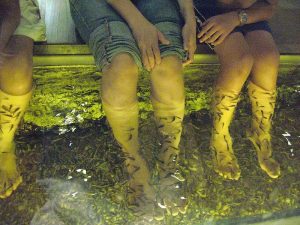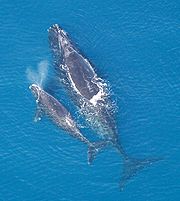Category Archives: Weird
Rather Strange Orange Lobster Saved From the Pot
So what exactly is so strange about an orange lobster? It’s actually living! Normally, lobsters are a brownish-green color when they are alive, and they turn orange when they have been cooked. That being the case, a strange live reddish-orange lobster has been sighted in the UK.
The lobster, which hails from North America, has been aptly named “Gumbo”. Gumbo is so rare that he was saved from becoming dinner, and was plunked down into a new home at the Birmingham National Sea Life Center.
Before making his way to the Sea Life Center, Gumbo was staying at the Natural History Museum I London. The museum was made aware of the rare find by fishmonger Rex Goldsmith. “I’ve never seen anything like it in 25 years in this business,” Rex commented.
Paul Clark, a crustacean researcher at the museum, was simply flabbergasted by extraordinary color of the carapace and agreed to aid Rex in finding a more suitable home for the lobster. “I was able to set up a saltwater tank here at the Museum to keep him alive until Sea Life agreed to take him and arrange collection.” Paul explained.
The shells of lobsters generally have red, yellow, and blue pigments which give them their brownish-green color when they are still alive.
The lobsters’ diet consists of shrimp, algae and other sea animals which contain cartenoid pigments.
These pigments are what give lobsters their color, and when they are cooked they break down and give them that “red” look.
Weird Yellow Colored Lobster Hauled in in R.I.
Denny Ingram reeled in a rather strange lobster in Narragansett Bay’s East Passage last week. It was peculiar indeed, this lobster you see, was gold colored on top, and bright yellow on its sides.
“I thought, holy cow, this is unusual. And no one else around here has ever seen anything like it either,” explained Ingram when asked to comment on the strange event.
They may be scarce, but they are not unheard of. This yellow coloring comes from a gene carried by both parents, and it makes itself apparent in roughly one out of every 30 million lobsters.
Slightly more common than these flashy yellow lobsters, are blue colored lobsters. The Audubon Education Center in Bristol has one of the blue little guys in its tidal pool. It replaced a previous blue occupant which was hauled in in 2003.
“The first blue lobster got too big — about a pound and three-quarters — so we released it back into the Bay,” explained director of the center, Anne Dimonti, “Now, we’re on our second one and it’s doing wonderfully.”
Ms. Dimonti has performed some research on these unusually colored lobsters and has found that estimates were all over the map as to how common they are. She explained that the estimates ranged from one in a million to one in 20 million. In her opinion, one in 4 million is the most commonly accepted figure.
“Being born a blue lobster is not so rare; what’s rare is surviving into adulthood as a blue lobster,” Dimonti explained. “When you’re a bright blue baby lobster walking around on the ocean bottom, somebody is going to pick you off very quickly.”
A New New York Bill May Ban Flesh Eating Fish Pedicures
The controversial use of live fish to chew away dead skin in pedicures may be banned in New York State for health and safety issues which have been proposed in a new bill.
The procedure in question was actually developed in Turkey, as a way to take care of a variety of ailments of the skin, such as psoriasis, consists of the feet being plunked into a tank of water which contains two different kinds of small fish. These rather hungry fish then proceed to eat away dead skin while leaving the healthy skin alone.
These “Fish Pedicures” are illegal in at least 14 different states, comments Senator Jeff Klein, of the Bronx and Westchester, who originally proposed the ban. The basis of the ban rests on the concern that fungal infections may be passed by unsanitized fish in unclean water. Of course the animal rights groups have jumped on the band wagon, pushing to outlaw the use of fish in pedicures as it is inhumane.
Robin Ross, the president of the New York Podiatic Medical Association, had this to say during a telephone interview: “I do not recommend it to anyone who has any diabetes or any immuno-compromised condition such as AIDS or cancer, because of the risk of infection. The fish are defecating and urinating in that water and you’re sticking your feet in it.” ”
The New York Department of State has gone on the record, saying that it is not aware of any of the 20,000 plus licensed nail salons engaging in such an activity. Apparently it is only being done on the down low, in backrooms of New York City.
The Sapphire Princess was Delayed By…. A Whale?
When the Sapphire Princess pulled into Juneau it was actually stopped in it’s tracks this Past Wednesday, when a dead whale was found on the ship’s bow.
The public affairs officer for National Geographic and Atmospheric Administration, Julie Speegle, has commented that the whale was discovered at just about 8 AM, when the ship was approaching Juneau, new Tracy Arm.
“It apparently became lodged there overnight,” she commented.
When the whale was discovered, the ship contacted the US Coast Guard, who then turned around and told the National Oceanic and Administration of the happenings. Both agencies rushed to the scene.
Speegle has commented that the vessel came to a halt in an area south of Douglas Island, but did not dock while a diving team worked to dislodge the hapless whale. After it was successfully taken off the ship, the whale was immediately transported by tug boat to undergo a necropsy to figure out what caused its death. A press release was then published by Princess Cruises saying that the whale was taken away through the Stephens Passage.
The job of removing the whale was completed and the vessel was then cleared to get on its way just after 3 PM, arriving about an hour afterward.
Speegle explained that this particular species of whale could not be deciphered until they completed the necropsy, “We don’t definitely know but photos from (NOAA) Protected Resources say it appears to be a juvenile humpback.”.
Hundreds Of Dead Penguins in… Brazil??
This is kind of weird… Apparently there are hundreds of dead penguins, who look like they’ve starved to death, are washing up on the beaches of Brazil of all places. This is very worrying for scientists on many levels, however the main focal point is just what is causing then to perish.
Somewhere in the neighborhood of 500 of the flightless birds have been found over the past week and a half on Peruibe, Praia Grande, and the Itanhaem beaches in Sao Paolo State. This comment comes from Thiago de Nascimento, who is a biologist with the Peruibe Aquarium.
The majority of these penguins were Magellan penguins, on their way north from Argentina, Chile and the Falkland Islands, searching for food in warmer waters.
What is so troubling scientists so much, is that many of these penguins are not finding the food they seek. Autopsies performed on many of the penguins revealed that their stomachs were entirely empty..
Researcher are investigating whether the fault lays in strong currents, or colder waters than what have been the norm, which may have caused the species the penguin relies on for food to thin out, or if maybe human activity is to blame.
“Overfishing may have made the fish and squid scarcer,” Nascimento has explained.
He also said that it is common for penguins to make their way north this time of the year. Unfortunately, some of them do happen to lose their way and perish from hunger or exhaustion, and then wind up dead on the Brazilian coast far from their homes.
However, in these numbers it is a grave concern… Hopefully they find an answer soon, before these creatures wind up the going the way of the do do bird.
Jumping Whale Lands on Top of Yacht!
Well, this is interesting.. A whale which was showing off its moves in Table Bay, jumped up out of the water “Free Willy” style, and what happens? The whale lands on top of a sailboat.
The whale flattened the steel mass and brought down the rigging before gallantly sliding back into the water and swimming on its way.
“It was quite scary,” commented Paloma Werner, who had previously been enjoying the trip with her boyfriend come business partner, Ralph Mothes.
“We thought the whale was going to go under the boat and come up on the other side. We thought it would see us.” Ms. Werner continued.
However, this was not the case, as the boat had its engine turned off.
The manager/scientist of the Cape Town Mammal Research Institute at the University of Pretoria, Meredith Thornton, shed some light onto the subject for us: “Whales don’t see much by way of their eyes but by sound in the water.”
Given that the whale had such poor eyesight, and that the water was particularly rough, Thornton commented that the whale, presumably a young whale most likely did not even realize the boat was in the way.
The hapless couple first spied the whale when it was a stone’s throw away, from their yacht. It jumped out of the water once, and before they could make a move, the whale was only a hair lengths away from the vessel.
“There was hardly any wind, so we couldn’t get out of the way,” countered Werner. “We didn’t have time to take any evasive action.”
This just goes to show you, when you are out gallivanting around, always keep your engines running.
Largest Blue Catfis Ever Caught – 130 Pounder Reeled in in the Missouri River!
What may be the world’s largest catfish was reeled in by Greg Bernal, from Florissant, and Janet Momphard, of St Charles.
This blue wonder, which was weighed in to be 130 pounds, beat the State record in Misouri by 27 pounds and might just outweigh the world record by 6 pounds.
This is amazing, as blue catfish generally only grow to be between 3 pounds and normally no more than 40 pounds, which suggests that the catfish dragged in had fed on his share of the food supply.
It took the couple around 15 minutes to drag the monstrous catfish toward their tiny fishing boat, kicking and screaming the whole way no doubt. It then took another 30 minutes to land the giant fish, and then only with the aid of two nets could they get the catch into their tiny fishing boat. The fish was caught in the Missouri River, close to the Columbia Bottom conservation area.
In order to catch this amazing catfish, they used a hunk of Asian Carp, which had willingly jumped into their boat, for bait.
There is still a lot of paperwork, and hemming and hawing to be done, before the catch is certified as a world record. However, the Missouri Department of Conservation has commented that there is no doubt at all, that this monstrous catfish broke the world record.
Baltic Wreck Turns Out 230 Year Old Champagne!
Divers have recently uncovered what might just be the world’s oldest champagne (which hasn’t turned to vinegar) in a shipwreck off the Baltic Sea. They celebrated by popping open a bottle even before they made it back to dry land.
Christian Ekstrom, a diving instructor, has said that the champagne is thought to be from the 1780s and was likely on its way to Russia before it met its fate. The origin of the wreck has not yet been determined.
“We brought up the bottle to be able to establish how old the wreck was,” he said at a press conference, “We didn’t know it would be champagne. We thought it was wine or something.”
He went on to say that the diving team was ecstatic when they popped open a bottle after hauling the find up some 200 feet (60 meters) out of the water.
“It tasted fantastic. It was a very sweet champagne, with a tobacco taste and oak,” Ekstrom vividly explained.
The wreck was discovered near the Aland Islands, between Sweden and Finland last Tuesday. Somewhere in the neighborhood of 30 bottles of the prime bubbly are thought to be aboard the sunken derelict ship.
Ekstrom has said that the age and authenticity of the champagne is beyond refute, however samples have been sent off to private laboratories in (where else?) France for testing. “We’re 98 percent sure already because of the bottle (we found),” he explains.. But then, wouldn’t your judgment be a little off after drinking a bottle of bubbly with some friends?
Stay Tuned for the outcome!
Wonder what that would go for on Ebay?
“Nesski” the Naughty Sea Monster?
Nessie’s Russian cousin, “Nesski” seems to be misbehaving in a rather morbid way. It seems to have acquired the taste for fishermen!
Nesski has now been attributed with 19 deaths in the Chany lake over the years. According to Russian experts, that number may actually be higher, but no one has taken note of it yet.
On the books, these deaths have been reported as drowning. However, it is interesting to note that of the “drowning” victims only a few have actually been recovered. The bodies that have been recovered have been reported to be “half eaten”. Off the record, this has led to the speculation by many of the local community that “Nesski” has acquired a taste for human flesh.
Nesski claimed its latest victim, a 59 year old man, when the hapless fisherman tried to reel it in last week. Vladimir Golishev, the man’s close friend, explains what happened. “I was with my friend… some 300 yards from the shore. He hooked something huge on his bait, and he stood up in the boat to reel it in. But it pulled with such force that he overturned the boat. I was in shock – I had never seen anything like it in my life. I pulled off my clothes and swam for the shore, not daring hope I would make it.”
Golishev did in fact make it back to the shore, however his long time fishing partner, vanished beneath the waves, never to be seen or heard from again.
This sad incident is a painful reminder of what happened only three short years ago, when Vladimir lost his 32 year old grandson to the Beast. Mikhail, a Russian soldier, was dragged beneath the lakes’ placid waters, after something large capsized his boat. “The lake was calm, but suddenly the boat was rocking, and it capsized.” recalled Mikhail’s grandmother, Nina Doronin.
The couple has lived on the shores of Chany their entire lives. They firmly believe that Nesski is real, and is responsible for the death of their grandson, as well as the other missing fishermen. The most frustrating aspect of the whole thing, is that they have never personally seen the monster responsible for the crime.
Nesski is thought to be a pleiosaur, much like its counterpart in the Loch Ness. A pleiosaur is an aquatic dinosaur with a rather long neck, small head, large body, and an almost comicly short tail and fins. According to experts on the subject however, these beats went extinct at the end of the Cretaceous period.
The reports of Nesski sightings have been coming in a steady flow for decades, though actually locating such a beast really shouldn’t be too difficult, given its habitat. The lake is only 57 x 55 miles across, and only 23 feet deep at its deepest.. Which begs the question.. Why has no one proven the existence of the monster? But more importantly… Why can’t you find the missing fisherman in water so shallow?
Paul the Octopus Hanging up His Tentacles, Spain Wants to Send Him to Pasture
I’m sure you have all heard about the amazing abilities of Paul the Octopus. He had the uncanny ability to accurately predict the outcome of the outcomes of the games of the world cup.. Well, now he can hang up his tentacles and sit back in his tank in Oberhausen, however, a village in Spain is vying to give him a new home.
This begs the question… How did he do it? It all started when someone, possibly as a joke, decided to place a single mussel in two different tanks with the different flags representing the teams, and supposedly he would select the mussel from the winning teams’ tank. This process worked rather well in 2008, where Paul only made one blunder, Germany didn’t win. However, this time around for the World Cup he had a 100% success rate!
No one can quite figure out why Paul has this uncanny ability, but there are many theories as to why he picked what he picked. Some say it could be based on a favorite color, and others say it might be based on smell. However he did it, he managed to be spot on with all his “predictions” for the world cup, warming the hearts, and sometimes the wallets, of fans around the world!
You would think Spain would be more appreciative of this amazing creature, considering he predicted their team would win.. However a small village has offered 30,000 Euro, to scoop up Paul, and not for his uncanny ability to predict the outcomes of games. They want to feature him in their Octopus food dish festival! How’s that for gratitude? Luckily for Paul, the citizens of Oberhausen will have none of that, and he’ll remain safely in his tank for the remainder of his retirement.







